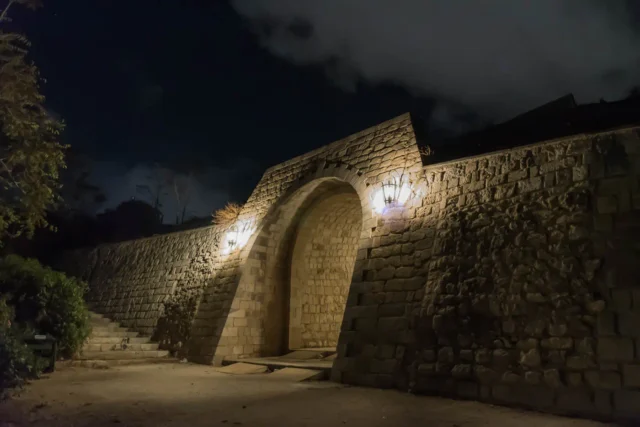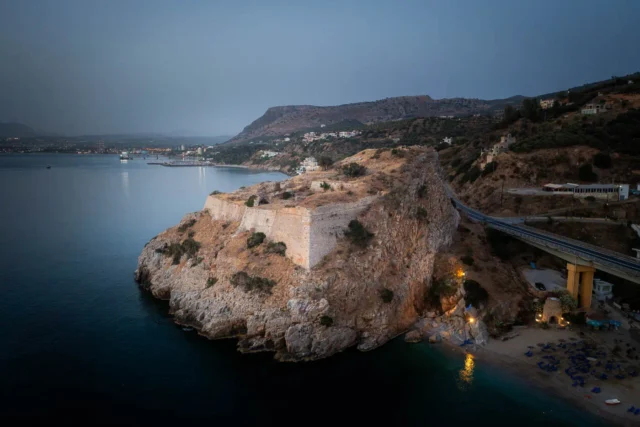A Hidden Portal in Heraklion’s Walls
The Dermata Gate, a relatively small but historically significant passageway, punctuates the coastal stretch of Heraklion’s Venetian walls. Positioned between the imposing Sabbionara and Agios Andreas Bastions, it once facilitated access to the city from the sea and played a supporting role in the city’s defense.
Construction and Early Usage
Built between 1590 and 1595, the Dermata Gate stands out for its economical construction. The Venetians, ever mindful of costs, opted to utilize readily available materials. They repurposed stones from demolished houses and employed forced labor from local peasants (known as “angarikoi”) to minimize expenses. Despite its budget-conscious construction, the gate’s facade facing the city interior was designed with a monumental flair, showcasing Venetian architectural sensibilities.
The gate earned its name, Dermata, from its proximity to the city’s tanneries. It was also referred to as the “Giudecca” or “Judaica” due to its location near the Jewish quarter. Functionally, the Dermata Gate served as a secondary access point to the city from the sea, acting as a backup in case the main harbor entrance was blockaded.
The Siege of Candia and the Dermata Gate
During the protracted Siege of Candia (1645-1669), the Dermata Gate witnessed dramatic events that shaped the city’s fate. In November 1668, under the cover of darkness, French reinforcements led by the Count de la Feuillade landed at the Dermata Gate. The Venetian defenders, desperately holding out against the Ottoman siege, relied on such reinforcements to bolster their dwindling numbers. However, the Ottomans, alerted to the landing, unleashed a barrage of cannon fire, resulting in the tragic drowning of many French soldiers. This incident underscored the vulnerability of the coastal defenses and foreshadowed the eventual fall of Candia to the Ottomans in 1669.
Modernization and Current Status
After the Ottoman conquest, the Dermata Gate continued to serve the city. However, the modernization efforts of the 20th century brought about drastic changes. In the years following World War II, a period marked by extensive urban redevelopment, the monumental facade of the Dermata Gate and its entire southern section were demolished to make way for the widening of Kallergon Street. The remaining portion of the gate was extended seaward with the construction of a new concrete tunnel, which later functioned as a rainwater drainage conduit.
The “Opening”
The Dermata Gate, unlike some other gates in Heraklion’s walls, was never “opened” in the sense of creating a new passage through it. Its historical function was always as a pedestrian gateway to the sea. However, the demolition of its facade and the extension of the remaining section with a concrete tunnel in the mid-20th century significantly altered its original form and function. This “opening,” while driven by the need for urban modernization, resulted in the loss of a significant portion of the gate’s historical fabric.
Fortifications: Key Points
- Construction Period: 1590-1595
- Location: Coastal stretch of Heraklion’s Venetian walls, between Sabbionara and Agios Andreas Bastions
- Historical Significance: Secondary sea access, landing point for reinforcements during the Siege of Candia
- Current Status: Partially demolished, remaining section extended seaward, accessible to the public
References
- Sythiakaki, V. (2020). The Heraklion Fortifications: A Different View. In N. Chr. Stampolidis & E. Papadopoulou (Eds.), Crete: Emerging Cities. Athens: Museum of Cycladic Art-ΥΠΠΟΑ.
- Georgopoulou, M. (2001). Venice’s Mediterranean Colonies. Architecture and Urbanism. Cambridge: Yale University-Cambridge University Press.

































There are no comments yet.